I’ve had experience making a bait beehive. For several years, I was taking notes, making videos, and now it’s time to share what it was like. I hope you will find it useful, as I have tried to bring in as many relevant facts and observations from practice as possible. So, here is my practical guide of how to build a bait hive for honey bees.
Bait hive – spring 2017. First steps.
As some people like to run around answering calls regarding swarms only to find that the majority are for bumblebees, wasps or the swarm has disappeared before they arrive.
So I like to set bait hives and try to lure a swarm to me. It’s hit and miss, and you have to treat it as fishing, sometimes you get something and others not so lucky, but what you do get is plenty of nibbles. It’s particularly attractive if you can position your bait hive close to where you can keep an eye on it to see if you have any scout bees checking it out. The excitement builds over a few days as you first see one, then two, six, ten and up to a couple of dozen scouts checking out your hive. You hope to see it go quiet and then anticipate the swarm arriving and sometimes does, but unfortunately not always.
The beekeeper has inspected their hive and found it on the verge of swarming. Or someone has collected the swarm from the tree. Or god forbid the bees somehow have made a mistake and chosen something else over your hive.
So you have to set up your bait hive to make it as attractive to the bees as possible. It is considered the bees prefer a space of 40 liters, this is an odd way of calculating a volume to me, but as I guess covers all shapes and sizes. The standard national brood box is ideal and ideally an old one with the inside gone over with a blow torch.
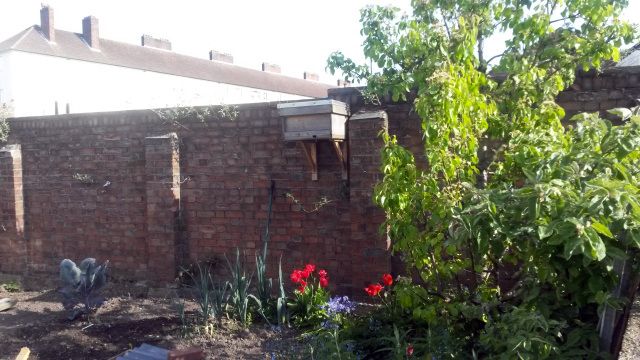
Next is a solid floor with a small entrance say 0,3 square inches. A mesh floor may let light in, and the bees don’t like that, you could block off the mesh floor, but also a simple solid floor is easy to make.
One old comb, but no stores what so ever as this will only encourage robbing and you will get all excited over nothing. The rest of the box is filled with foundationless frames, and I think the bees prefer the foundationless frames over foundation.
Crown board with holes covered by a mesh of sorts leave any holes open, and you may find your swarm, making comb in the roof cavity first, finally the roof.
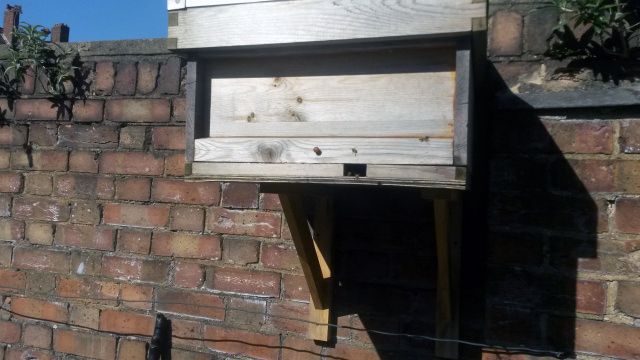
Ideally, you want the hive approx 6-7ft off the ground and facing south, or at least in plenty of suns through the day. I have fitted them up trees, on garage rooves and my current one sitting on two brackets fixed to a wall. As this may involve a ladder or steps, I screw my floor and crown board to the brood box so when getting the now heavier box down, full of bees there is no danger of the whole lot coming apart.
I also remove the roof first, and as by far you have sealed the bees into the hive the mesh over any feed hole comes into its own as ventilation. Small but some nevertheless.
The final bit is to put a couple of drops of lemongrass oil onto a piece of the foundation, roll it up and slip it into the hive entrance as an extra attractant. But the old brood box and old comb are perhaps enough.
I prefer to set up brood boxes with a full complement of frames and this way if a swarm moves in I don’t have to worry straight away in moving it and can give it plenty of time to settle, build comb and start to raise brood. Last year I picked up a cast swarm and left them in situ most of the season, and they built up to a wonderful colony by the end of the season, although the hive was rather heavy by the time I came to move them off the roof.
One year I made some simple plywood boxes intending to sight them in places that I would not visit that often and also it would be no great problem if someone decided to take them. One picked up a tiny cast swarm, but so small they never came to anything and why a cast could be that little was unusual, perhaps a teacup of bees and could have been from an absconding mating nuc?
I recommend that if you have space and spare kit you should give it ago as its great fun, especially if you can keep a close watch on the entrance. I have considered putting one on my boat this year, perhaps just a nuc box to see what happens.
Bait hive – April 2018. Takers, where are you?
April – it’s that time of year again fishing for a swarm, just going to set the one hive again this year and in the same location as last year very close to my small workshop so that I can watch it during the days. I have even gone to the trouble of sprucing the hive up with a bit of colored preserver, especially as it is now sitting close to my fancy bug hotel.

Last year the bait hive had a good bit of interest from scout bees throughout the year but sadly no takers. However, early on, I had to close the hive for a week as I spotted a queen wasp showing interest. And at the end of the year when I took the hive down, I found the efforts of her attempts to build a nest and hope she was able to establish her own colony elsewhere. I also had a couple of long-tailed tits showing interest and did wonder if I was going to have a birds nest come to the end of the year. But they lost interest after a while and left rather a lot of bird poo in the hive, a bird public toilet the very cheek of it.
After the interest of the queen wasp and the birds, the hive settled down with typical interest from scouts. On one occasion lots of attention with very excited scouts. I was expecting a swarm with a camera at the ready but had to go out to inspect the bees at Kew and hoped I would not miss the excitement. When I returned, I noticed the scout bees were still at the hive, but their mood had changed – they were sitting at the entrance with occasional flights at the hive.
This activity continued but with dwindling bees over about seven days. All I could think to explain this activity was that there was a swarm out close by and perhaps collected by a beekeeper who removed the swarm when the scouts were at my bait hive. The scouts were returning to the swarm and finding it gone returned to the bait hive hoping the swarm would arrive. I guess I will never know but for me another example as to the fascination in bait hives.
This bait hive is partly made from a hive I made nine years ago and made in a panic as my hive had swarmed and I had to make one in double-quick time. So this hive is entirely appropriate to be used as a bait hive. It’s also made with no joints and is screwed and glued together with stainless steel screws and is almost as good as the day it was made. It goes to show you can make good bait hives from very simple construction.
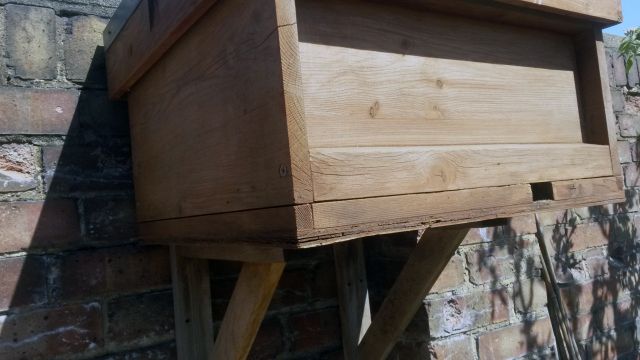
The setup of the bait hive. It’s a solid floor with a small entrance. A full complement of 12 frames not all the same and a mix of various frame spacing styles including a couple with a part built comb. Two odd frames I was given with super foundation fitted in them and thought they ran out of the deep foundation. To hold the super foundation in place, I ran a wire across the frame picking up the two loops in the bottom of the foundation wire, crown board with feed holes covered with mesh. The mesh it there just in case I pick up a swarm and want to move them I can block the entrance with mesh and with the mesh in the feed holes will give the bees some ventilation during the move and finally a roof. The floor and crown board are both screwed to the brood box to keep everything together when I have to move it. The hive is also screwed to the two wall brackets.
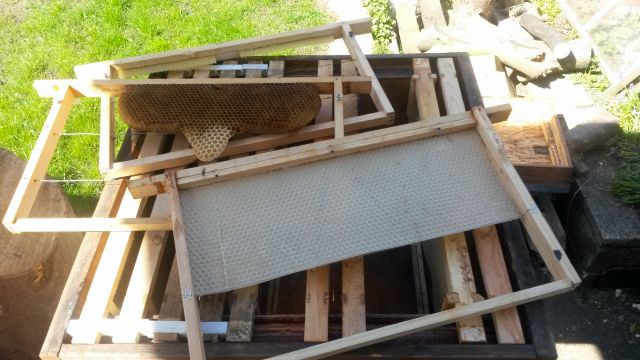
That’s it, and all I have to do other than keep an eye on the entrance is put a couple of drops of lemongrass oil onto a bit of foundation, roll it up and slip it in the entrance every few weeks to help with attracting scout bees. I think to sum it up to you either like fishing. Bee fishing.
I have a small time-lapse camera with a waterproof case that I intend to set up to watch the entrance hoping to catch a swarm arrive once. If I get some interest, I can set it to take a shot every few seconds so it will be a similar video to some of my boat moving videos, but the real joy will be watching one arrive. Fingers crossed.
Bait hive – May 2019. Big swarm!

The result from the bait hive enticed a big swarm into it, and it took a few days from the first scout bees to them arriving on mass, seven days to be precise.
- Monday, May 13
The first couple of scout bees arrived at the hive, and I took no great interest at this as this can be quite common. But an hour later I noticed about a dozen and this got my attention as that was a reasonably rapid increase, and at first thought, things would advance at a pace.
- Tuesday, May 14
The scouts returned and increased to about two dozen, getting very excited checking all round the hive, hovering in front of the entrance and investigating the inside of the hive. What the scouts are doing during this investigation and looking at the hive, well it’s not a hive to them, it’s just a convenient potential nest site and could be any cavity. What they are doing is very calculated and deliberate, looking for questions to a list of requirements they have. They are:
- looking at the height from the ground, not perfect in this case as they prefer something higher as it gives protection from bears.
- calculating the size of the entrance not too large to cause a draught and hard to defend but not to small that it would cause congestion at busy times.
- looking at the direction the entrance is facing and prefer south facing.
- checking all round the nest site looking for any other entrances.
- assessing if the cavity is dry.
When they venture inside the potential nest site, they are assessing the position of the entrance about the cavity as they prefer a bottom entrance. Over a series of trips inside the hive, they are calculating the volume of the cavity, and they prefer a 40l cavity. To the bees, this could be a reasonably long thin cavity as common with tree cavities but just as happy with a short fat cavity and just so happens a standard national brood box is approx 40l.
If the potential nest site ticks all or some of the boxes to the scout or scouts looking at the nest site they return to their original site or swarm. They communicate the location of the site with the other scouts using the same bee dance as they use for locating forage and those scouts go to see for themselves. But also may have been looking at a different nest site themselves in the opposite direction, so they communicate this to the other scouts, and they go and check out that site. So the scouts are checking out each other’s potential nest sites, and if one scout thinks the site chosen by the other scout is better than her site, she will join forces and perform the same dance favoring the other site. This can go on for some time until hopefully, the scouts agree that they have found the best available nest site for them to swarm to. So the bees are communicating to one another and debating what the best site to move to is.
During the rest of Tuesday the scouts continued and increased to 30+ as more were starting to favor my bait hive.
- Wednesday, May 15
Day started the same but now perhaps 40+ scout bees at the hive. This time they were showing signs that they were guarding the hive. Not aggressive guarding but bees are hanging around the entrance gently challenging bees as they entered the hive. At approx 12:30 I noticed the hive go quiet for about 35-40 minutes. I thought either the beekeeper has inspected and found the hive on the verge of swarming and performed an artificial swarm or the swarm is on its way as the scouts leave to guide the swarm to the new nest site. After this, I had to go and do something away from the garden but was called by my good beekeeping neighbor informing me a swarm has been seen hovering over the school playground heading my way. I went back to the garden expecting to see the swarm but nothing just the same amount of scout bees.
I now think the swarm over the school could be the swarm that eventually moved into the bait hive and the bait hive going quiet was the time that colony swarmed, but for some reason, the swarm relocated when the scouts were at my bait hive.
- Thursday, May 16
Forecast was for heavy rain most of the day. Thinking about it if the swarm was clustered in a tree or similar then it to would have had to encounter the rain but then the way they naturally cluster would cause some protection. One great thing about the European Honey Bee is it has developed coping strategies to deal with problems. Swarms getting caught in bad weather is perhaps just one problem they have evolved to deal with providing the bad weather is not extreme.
- Friday, May 17
Friday was going to be the day as I was convinced it was going to happen. Although in the past it has taken five days and this was day four, I thought the high numbers of scouts must be positive, but once again it was a no the bees were just not ready.
- Saturday, May 18
Day was the same as I started to doubt if it was going to happen.
- Sunday, May 19
Again, day started the same as previous day’s loads of scouts at the hive and the guarding of the entrance. I went to check my bees. I would check the other hives first just as it could be rather embarrassing if the scouts turned out to be from one of my hives. I had just finished them and thankfully, all behaving themselves when I got a message to call the house. It was my neighbor beekeeper who owns the house and garden. The bait hive is in rather worried as there are thousands of bees flying all around the garden. I shot round to catch the last of the bees landing on the hive marching in through the entrance and forming a large cluster under the hive. Even though I missed the arrival, it was still a magical moment.
There is one problem with swarms, and it’s you just don’t know what you are going to get regarding temperament and health. But thankfully the bees seem rather nice as I have stood very close to the entrance and they have not bothered me and fly around me, and a large swarm must indicate a healthy colony. I will let them stay in situ for a couple more days and then move them to one of my apiaries so they can be transferred into another hive and I can reset the bait hive and more importantly see what I have, a prime swarm with a marked or unmarked queen or a huge cast but more likely a prime swarm.
I don’t know if the swarm is from a wild colony or a managed one but if from a wild colony in another six days a few cast swarms could be about or there is always the chance and plenty of time of another big swarm from another colony.
Bait hive – June 2019. Success!
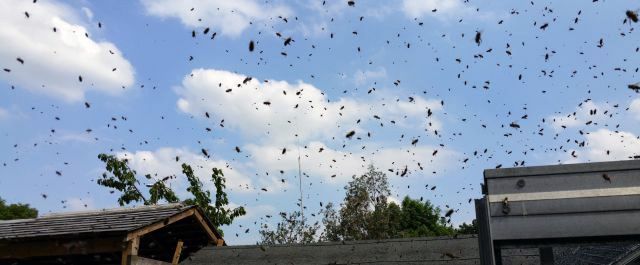
A great result and real thrill to be at the garden as a swarm arrived and moved into a bait hive I set up just that very morning.
Standing in the center of thousands of swarming bees is a beautiful experience and the noise they make something else.
I had been slow setting a bait hive this year and was thinking about giving it a miss. But when a converted 14×12 BB that I had used to transform my TBH back to national hive suddenly became attractive to a few bees. I thought a swarm could be close by so I moved the 14×12 BB to one side and set up a bait hive in its place with frames and starter strips to see what may happen.
It was pretty clear that these were not just a few bees checking out a box that smelt attractive and could hold some goodies. But scouts on the lookout for a new home with typical scout bee activity, checking the entrance, all around the hive and investigating the interior, checking the size to see if it’s a beautiful cozy space.
With the increasing number of scouts, I knew my bait hive was gaining favor amongst the scouts over any other potential nest site. Scouts during swarming communicate between each other identifying various possible nest sites. They do this by performing the same bee dance they do to identify new plants to forage. Each scout, in turn, visits these sites, and if a scout favors one site, they perform the same dance identifying that site. Eventually, the vast majority agree, and with the majority of scouts doing the same dance, it triggers the swarm to move to the new location.
You get a good indication your bait hive has been chosen as all the scouts leave in a very short time indicating the scouts are going to collect the swarm and guide it to your bait hive. If the hive started to go quiet slowly with fewer bees at the entrance and eventually no bees, then this could indicate a more favorable site has been discovered by the bees and slowly they are switching to that site, or someone has collected the swarm from a tree or wherever they were clustered. It is also possible the beekeeper has inspected the hive and found advanced queen cells and performed an artificial swarm.
So I was delighted when I spotted the hive had suddenly gone quiet with no bees, and I spent the next 15 minutes looking up into the sky, and then I spotted this dark cloud of bees moving along the rooves of the houses towards the garden.
Well, I thought how easy was that a beautiful big prime swarm that came to me and from the looks of it at this early stage very nice bees but the bees were determined to make me work a bit harder as I found this the following morning.
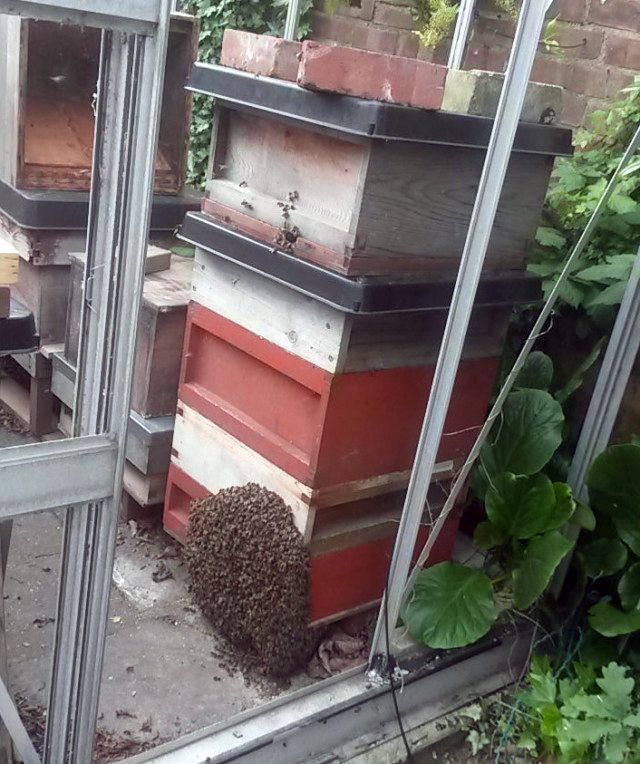
Don’t exactly know what happened here but I do remember seeing about five excitable bees low down on the stack as I was going home. Although I looked at them I didn’t notice a queen, but it was possible she never went into the hive, and the bees left to be with her. I soon scooped them up and put them in the hive, and they seemed to be very happy with many bees fanning at the entrance showing their nasonov gland guiding in any bees away from the entrance.
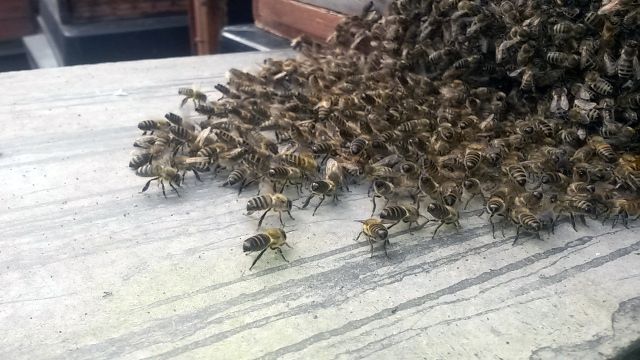
To help them settle in for the second time, I gave them a frame of honey. For a bit of security, I fitted a small piece of queen excluder over the entrance for a couple of days until I could see a reasonable amount of pollen going into the hive.
Overall I feel very lucky to have been there at the right time and day. It’s been an ambition of mine to experience this for many years, and now I want to do it again.
If interested to learn more about this fascinating part of the bees life then the book Honeybee Democracy by Thomas D. Seeley is the perfect book.
Update
Two weeks after the swarm arrived at the bait hive, I carried out my first inspection, and the bees are just lovely. The queen was unmarked and going about her business calmly and efficiently with several frames of brood and eggs. Of the ten new foundationless frames, all but the outer two were fully drawn with the most beautiful white wax. Without a doubt, you get the most beautiful white wax from swarms on foundationless frames and also a tiny drone comb compared to the usual 20%. I can now make arrangements to move them, and if the emerging brood continues to be so calm, I may move them again to one of my more public apiaries. They will also need a super very soon and even a 2nd BB if the queen continues to lay at the rate she is.
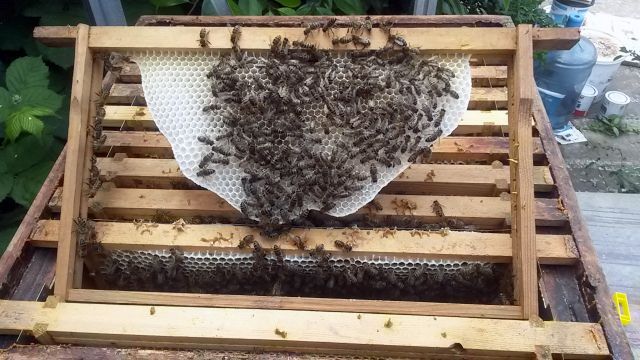
Bait hive – June 2017. Success!

The result from the bait hive enticed a big swarm into it, and it took a few days from the first scout bees to them arriving on mass, seven days to be precise.
- Monday, May 15
The first couple of scout bees arrived at the hive, and I took no great interest at this as this can be quite common. But an hour later I noticed about a dozen and this got my attention as that was a reasonably rapid increase, and at first thought, things would advance at a pace.
- Tuesday, May 16
The scouts returned and increased to about two dozen, getting very excited checking all round the hive, hovering in front of the entrance and investigating the inside of the hive. What the scouts are doing during this investigation and looking at the hive, well it’s not a hive to them, it’s just a convenient potential nest site and could be any cavity. What they are doing is very calculated and deliberate, looking for questions to a list of requirements they have. They are:
- looking at the height from the ground, not perfect in this case as they prefer something higher as it gives protection from bears.
- calculating the size of the entrance not too large to cause a draught and hard to defend but not to small that it would cause congestion at busy times.
- looking at the direction the entrance is facing and prefer south facing.
- checking all round the nest site looking for any other entrances.
- assessing if the cavity is dry.
When they venture inside the potential nest site, they are assessing the position of the entrance about the cavity as they prefer a bottom entrance. Over a series of trips inside the hive, they are calculating the volume of the cavity, and they prefer a 40l cavity. To the bees, this could be a reasonably long thin cavity as common with tree cavities but just as happy with a short fat cavity and just so happens a standard national brood box is approx 40l.
If the potential nest site ticks all or some of the boxes to the scout or scouts looking at the nest site they return to their original site or swarm. They communicate the location of the site with the other scouts using the same bee dance as they use for locating forage and those scouts go to see for themselves. But also may have been looking at a different nest site themselves in the opposite direction, so they communicate this to the other scouts, and they go and check out that site. So the scouts are checking out each other’s potential nest sites, and if one scout thinks the site chosen by the other scout is better than her site, she will join forces and perform the same dance favoring the other site. This can go on for some time until hopefully, the scouts agree that they have found the best available nest site for them to swarm to. So the bees are communicating to one another and debating what the best site to move to is.
During the rest of Tuesday the scouts continued and increased to 30+ as more were starting to favor my bait hive.
- Wednesday, May 10
Day started the same but now perhaps 40+ scout bees at the hive. This time they were showing signs that they were guarding the hive. Not aggressive guarding but bees are hanging around the entrance gently challenging bees as they entered the hive. At approx 12:30 I noticed the hive go quiet for about 35-40 minutes. I thought either the beekeeper has inspected and found the hive on the verge of swarming and performed an artificial swarm or the swarm is on its way as the scouts leave to guide the swarm to the new nest site. After this, I had to go and do something away from the garden but was called by my good beekeeping neighbor informing me a swarm has been seen hovering over the school playground heading my way. I went back to the garden expecting to see the swarm but nothing just the same amount of scout bees.
I now think the swarm over the school could be the swarm that eventually moved into the bait hive and the bait hive going quiet was the time that colony swarmed, but for some reason, the swarm relocated when the scouts were at my bait hive.
- Thursday, May 11
Forecast was for heavy rain most of the day. Thinking about it if the swarm was clustered in a tree or similar then it to would have had to encounter the rain but then the way they naturally cluster would cause some protection. One great thing about the European Honey Bee is it has developed coping strategies to deal with problems. Swarms getting caught in bad weather is perhaps just one problem they have evolved to deal with providing the bad weather is not extreme.
- Friday, May 12
Friday was going to be the day as I was convinced it was going to happen. Although in the past it has taken five days and this was day four, I thought the high numbers of scouts must be positive, but once again it was a no the bees were just not ready.
- Saturday, May 13
Day was the same as I started to doubt if it was going to happen.
- Sunday, May 14
Again, day started the same as previous day’s loads of scouts at the hive and the guarding of the entrance. I went to check my bees. I would check the other hives first just as it could be rather embarrassing if the scouts turned out to be from one of my hives. I had just finished them and thankfully, all behaving themselves when I got a message to call the house. It was my neighbor beekeeper who owns the house and garden. The bait hive is in rather worried as there are thousands of bees flying all around the garden. I shot round to catch the last of the bees landing on the hive marching in through the entrance and forming a large cluster under the hive. Even though I missed the arrival, it was still a magical moment.
There is one problem with swarms, and it’s you just don’t know what you are going to get regarding temperament and health. But thankfully the bees seem rather nice as I have stood very close to the entrance and they have not bothered me and fly around me, and a large swarm must indicate a healthy colony. I will let them stay in situ for a couple more days and then move them to one of my apiaries so they can be transferred into another hive and I can reset the bait hive and more importantly see what I have, a prime swarm with a marked or unmarked queen or a huge cast but more likely a prime swarm.
I don’t know if the swarm is from a wild colony or a managed one but if from a wild colony in another six days a few cast swarms could be about or there is always the chance and plenty of time of another big swarm from another colony.
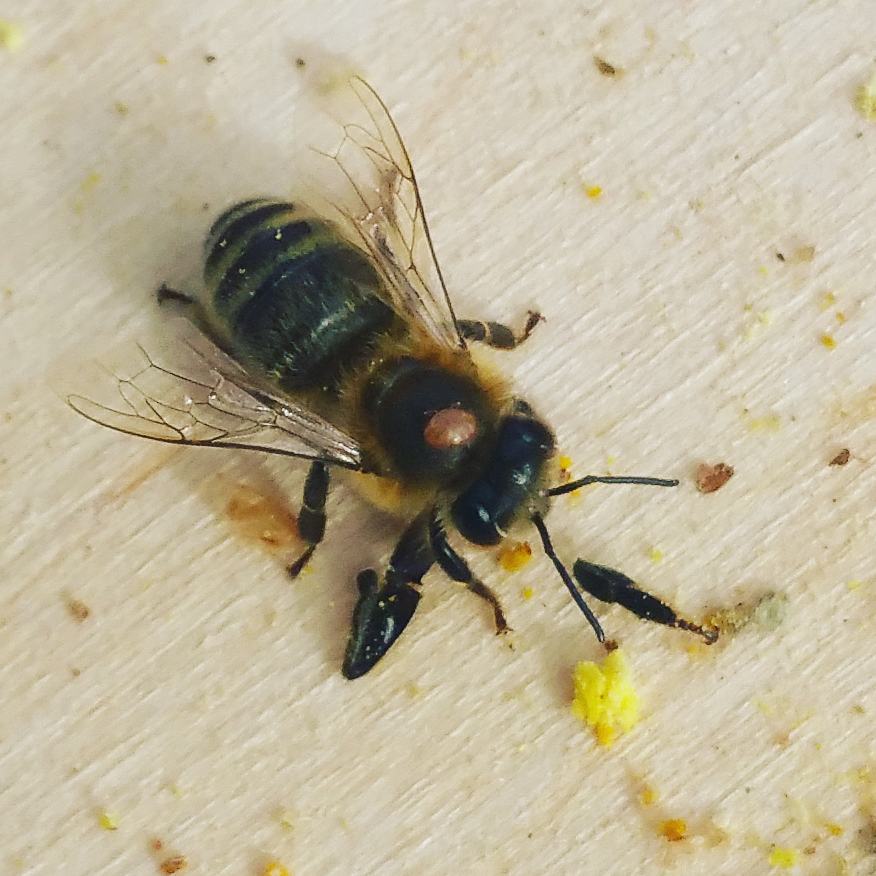
Varroa mites on the honeybee’s back. Notice how small it is?
